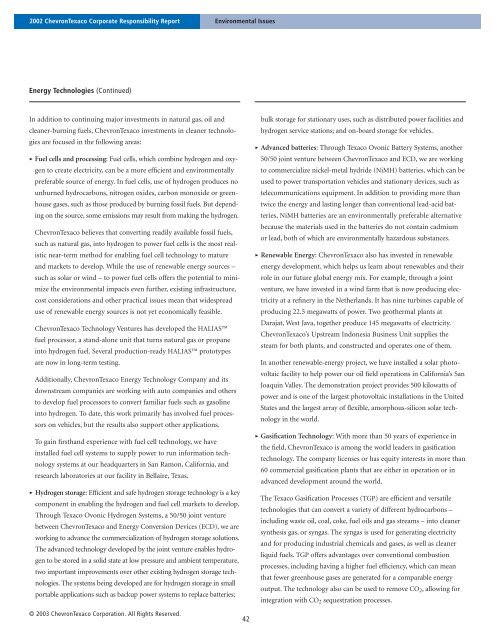Download PDF - Chevron
Download PDF - Chevron
Download PDF - Chevron
Create successful ePaper yourself
Turn your PDF publications into a flip-book with our unique Google optimized e-Paper software.
2002 <strong>Chevron</strong>Texaco Corporate Responsibility Report Environmental IssuesEnergy Technologies (Continued)In addition to continuing major investments in natural gas, oil andcleaner-burning fuels, <strong>Chevron</strong>Texaco investments in cleaner technologiesare focused in the following areas:> Fuel cells and processing:Fuel cells, which combine hydrogen and oxygento create electricity, can be a more efficient and environmentallypreferable source of energy. In fuel cells, use of hydrogen produces nounburned hydrocarbons, nitrogen oxides, carbon monoxide or greenhousegases, such as those produced by burning fossil fuels. But dependingon the source, some emissions may result from making the hydrogen.<strong>Chevron</strong>Texaco believes that converting readily available fossil fuels,such as natural gas, into hydrogen to power fuel cells is the most realisticnear-term method for enabling fuel cell technology to matureand markets to develop. While the use of renewable energy sources –such as solar or wind – to power fuel cells offers the potential to minimizethe environmental impacts even further, existing infrastructure,cost considerations and other practical issues mean that widespreaduse of renewable energy sources is not yet economically feasible.<strong>Chevron</strong>Texaco Technology Ventures has developed the HALIASfuel processor, a stand-alone unit that turns natural gas or propaneinto hydrogen fuel. Several production-ready HALIAS prototypesare now in long-term testing.Additionally, <strong>Chevron</strong>Texaco Energy Technology Company and itsdownstream companies are working with auto companies and othersto develop fuel processors to convert familiar fuels such as gasolineinto hydrogen. To date, this work primarily has involved fuel processorson vehicles, but the results also support other applications.To gain firsthand experience with fuel cell technology, we haveinstalled fuel cell systems to supply power to run information technologysystems at our headquarters in San Ramon, California, andresearch laboratories at our facility in Bellaire, Texas.> Hydrogen storage: Efficient and safe hydrogen storage technology is a keycomponent in enabling the hydrogen and fuel cell markets to develop.Through Texaco Ovonic Hydrogen Systems, a 50/50 joint venturebetween <strong>Chevron</strong>Texaco and Energy Conversion Devices (ECD), we areworking to advance the commercialization of hydrogen storage solutions.The advanced technology developed by the joint venture enables hydrogento be stored in a solid state at low pressure and ambient temperature,two important improvements over other existing hydrogen storage technologies.The systems being developed are for hydrogen storage in smallportable applications such as backup power systems to replace batteries;bulk storage for stationary uses, such as distributed power facilities andhydrogen service stations; and on-board storage for vehicles.> Advanced batteries: Through Texaco Ovonic Battery Systems, another50/50 joint venture between <strong>Chevron</strong>Texaco and ECD,we are workingto commercialize nickel-metal hydride (NiMH) batteries, which can beused to power transportation vehicles and stationary devices, such astelecommunications equipment. In addition to providing more thantwice the energy and lasting longer than conventional lead-acid batteries,NiMH batteries are an environmentally preferable alternativebecause the materials used in the batteries do not contain cadmiumor lead, both of which are environmentally hazardous substances.> Renewable Energy: <strong>Chevron</strong>Texaco also has invested in renewableenergy development, which helps us learn about renewables and theirrole in our future global energy mix. For example, through a jointventure, we have invested in a wind farm that is now producing electricityat a refinery in the Netherlands. It has nine turbines capable ofproducing 22.5 megawatts of power. Two geothermal plants atDarajat, West Java, together produce 145 megawatts of electricity.<strong>Chevron</strong>Texaco’s Upstream Indonesia Business Unit supplies thesteam for both plants, and constructed and operates one of them.In another renewable-energy project, we have installed a solar photovoltaicfacility to help power our oil field operations in California’s SanJoaquin Valley. The demonstration project provides 500 kilowatts ofpower and is one of the largest photovoltaic installations in the UnitedStates and the largest array of flexible, amorphous-silicon solar technologyin the world.> Gasification Technology:With more than 50 years of experience inthe field, <strong>Chevron</strong>Texaco is among the world leaders in gasificationtechnology. The company licenses or has equity interests in more than60 commercial gasification plants that are either in operation or inadvanced development around the world.The Texaco Gasification Processes (TGP) are efficient and versatiletechnologies that can convert a variety of different hydrocarbons –including waste oil, coal, coke, fuel oils and gas streams – into cleanersynthesis gas, or syngas. The syngas is used for generating electricityand for producing industrial chemicals and gases, as well as cleanerliquid fuels. TGP offers advantages over conventional combustionprocesses, including having a higher fuel efficiency, which can meanthat fewer greenhouse gases are generated for a comparable energyoutput. The technology also can be used to remove CO 2 ,allowing forintegration with CO 2 sequestration processes.© 2003 <strong>Chevron</strong>Texaco Corporation. All Rights Reserved.42
















